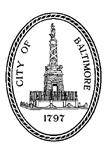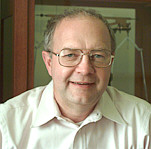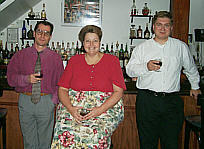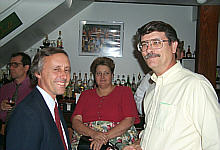



 October
Historical Events in Spectroscopy by Leopold May, Catholic University
October
Historical Events in Spectroscopy by Leopold May, Catholic University
From the Chairman - Local Section News
I'm going out on a limb - two limbs actually! Our next speaker will be Dr. Richard Suenram from the Optical Technology Division at NIST. He will discuss Fourier Transform Microwave (FTMW) Spectroscopy and current applications of this determinative identification technique. So why did I claim that I was going out on a limb? The last opportunity that I had to chair the local section, I tended to deviate from topics focusing on more traditional AA and ICP inorganic metals analysis, and brought forward spectroscopic techniques used to perform organic analyses (since I am more of an organic chemist than an inorganic kind of guy). Well, lightening does strike twice, and the topic of this month's presentation on Thursday, November 4, 1999 will again explore the boundary between spectroscopy and analysis of organic compounds. I invite you to come and learn about the utility of this exciting analytical technique.
The second limb has to do with the restaurant choice. Sir Walter Raleigh Inn in Montgomery Village has long been a favorite meeting location until the unfortunate "incident" that occurred in December 1998. I have discussed the matter and our concerns with the restaurant manager to ensure we do not have a repeat performance - he remembered the past situation (Diana must have made quite an impression), and promises me that the service will be as we remember from years past.
Many thanks to Mike Epstein for providing a web-based summary of our first
meeting complete with digital photographs. Dr. Marcus Schuetz provided an excellent
presentation and the turn-out was equally impressive. Also, thanks are in order
to members of the local section including Kris Patterson for compiling the newsletter
(also now available via e-mail in pdf format - contact her to receive the newsletter
electronically), Dave Hill for distributing the newsletter, Jeb Taylor for serving
for so many years as our dedicated treasurer, and chair-elect John Canham for
working to get new local section sponsors. Speaking of our sponsors, please
welcome our newest sponsor, Spectral
Dimensions of Olney, Maryland. Its product line encompasses systems for
performing FT-IR, NIR, and Raman imaging in a variety of basic research and
process control applications.
I hope that all SAS participants to the FACSS meeting have a great time in Vancouver,
British Columbia. Come to our next local chapter meeting on Thursday, November
4th, and bring your FACSS updates to the folks who were unable to make this
year's meeting!
Sincerely,
Larry Pollack
November Meeting Notice - Thursday, November 4, 1999 (Downloadable meeting notice PDF here)
Fourier Transform Microwave Spectroscopy: Historical Perspectives and the Evolution Toward an Analytical Technique.
In 1981 the late Willis H. Flygare and his group of graduate students and post doctoral associates developed a new microwave spectroscopic technique that revitalized the field of rotational spectroscopy. The new technique involved the used of a tunable Fabry-Perot microwave cavity in conjunction with a pulsed molecular beam valve and pulsed microwave radiation. The technique has evolved into what is now known as Fourier Transform Microwave (FTMW) spectroscopy. As it was initially introduced, it proved to be a powerful technique for studying the rotational spectra of hydrogen bonded dimers and van der Waals complexes. This trend continued throughout the 1980's as more and more research laboratories around the world constructed this type of instrument. It is estimated that today there are approximately 30 laboratories that have one or more of these instruments in use. The first NIST instrument was constructed in 1985 and was used to study a number of van der Waals complexes as well as hydrogen bonded dimers and trimers. More recently the emphasis at NIST has shifted toward the analysis and characterization of larger organic monomers with molecular weights in the 100 to 200 amu range. The 1K temperature of the molecular beam greatly simplifies the spectra of these compounds and permits their analysis. Over time, many changes have been made in the instrument resulting in dramatic improvements in overall sensitivity of the technique as well as greatly improved ease of use. In the early 1990's it became clear that this technique could offer some advantages to the analytical chemistry community as a new spectroscopic technique for trace gas analysis. Several laboratories have begun to address this issue. In the presentation, general historical perspectives will be given, in addition to describing details of the development of an analytical prototype FTMW spectrometer at NIST.
 Dr.
Richard Suenram is the Group Leader of the Spectroscopic
Applications Group, Optical Technology Division, Physics Laboratory at NIST
where he has worked since 1975. He has received the Bronze Medal Award from
the US Department of Commerce for his contributions to the spectroscopic sciences.
Prior to joining NIST, Dr. Suenram was employed in industry by Rohm and Haas.
He has a Ph.D. and MS in Physical Chemistry, from the University of Kansas (Lawrence)
and the University of Wisconsin (Madison), respectively. His research interests
are in the areas of hydrogen-bonded and van der Waals complexes, atmospheric
molecules, reaction mechanisms, and conformational equilibria of large organic
compounds using Fourier Transform microwave (FTMW) spectroscopic techniques.
He has also extensively used FTMW spectroscopy for trace gas analysis. Currently,
Dr. Suenram is developing new terahertz instrumentation and methods for studying
ro-vibrational spectra of molecules in this region.
Dr.
Richard Suenram is the Group Leader of the Spectroscopic
Applications Group, Optical Technology Division, Physics Laboratory at NIST
where he has worked since 1975. He has received the Bronze Medal Award from
the US Department of Commerce for his contributions to the spectroscopic sciences.
Prior to joining NIST, Dr. Suenram was employed in industry by Rohm and Haas.
He has a Ph.D. and MS in Physical Chemistry, from the University of Kansas (Lawrence)
and the University of Wisconsin (Madison), respectively. His research interests
are in the areas of hydrogen-bonded and van der Waals complexes, atmospheric
molecules, reaction mechanisms, and conformational equilibria of large organic
compounds using Fourier Transform microwave (FTMW) spectroscopic techniques.
He has also extensively used FTMW spectroscopy for trace gas analysis. Currently,
Dr. Suenram is developing new terahertz instrumentation and methods for studying
ro-vibrational spectra of molecules in this region.
Date: Thursday, November 4, 1999
Place: Sir Walter Raleigh Inn, 19100 Montgomery Village Avenue, Gaithersburg, Maryland, (301) 258-0576
Time: 6 pm Social Hour (cash bar), 7 pm Dinner, 8 pm Seminar
Cost: $20 ($12 students) Menu: Choice of 1) Thick Cut Prime Rib, 2) Baked Orange Roughy, 3) 12 Ounce Sirloin Steak, or 4) Hawaiian Chicken Breasts. Included with each entrée is the extensive salad bar/bread, rice pilaf, coffee, tea, soft drink, and chocolate mousse.
PLEASE INDICATE MENU CHOICE WHEN LEAVING YOUR RESERVATION
Reservations: Please make your reservations by NOON, Tuesday, November 2, 1999 by calling Larry Pollack at work (703) 810-4351 or at home (703) 256-6769, or e-mail at larry.pollack@dtra.mil
Directions: From I-270, take the Montgomery Village Avenue exit (Exit 11: Route 124, Montgomery Village Avenue). Travel east on Montgomery Village Avenue for approximately 1.5-2.0 miles, passing Lake Forest Mall and then a large lake on the right. The restaurant, a white house, is on the left in a strip mall shortly after the lake
September 30th Meeting Summary
(Click on the photos for larger image)

 The
meeting was held at the West End Grill in Bethesda, Maryland. About 20 of the
SAS faithful arrived on a beautiful fall evening to partake of good food and
entertainment. We had the restaurant pretty much to ourselves, and gathered
around the bar to renew old acquaintances and make new ones. A large contingent
from the US Department of Agriculture, Food Composition Laboratory arrived for
the talk by Marcus Schuetz. In the photo on the left are (left to right) Albert
Gilmutdinov (Guest scientist from Russia at USDA), Nancy Miller-Ihli (USDA),
and our speaker, Marcus Schuetz (USDA). At the right (left to right) are Bob
Koons, FBI and James Harnly, USDA.
The
meeting was held at the West End Grill in Bethesda, Maryland. About 20 of the
SAS faithful arrived on a beautiful fall evening to partake of good food and
entertainment. We had the restaurant pretty much to ourselves, and gathered
around the bar to renew old acquaintances and make new ones. A large contingent
from the US Department of Agriculture, Food Composition Laboratory arrived for
the talk by Marcus Schuetz. In the photo on the left are (left to right) Albert
Gilmutdinov (Guest scientist from Russia at USDA), Nancy Miller-Ihli (USDA),
and our speaker, Marcus Schuetz (USDA). At the right (left to right) are Bob
Koons, FBI and James Harnly, USDA.
Next, dinner was served in the main dining room. We were able to choose directly from a large selection on the menu, and the food was great. No wonder the West End Grill has become one of our favorite meeting places.
At the dinner table, from left to right above are Jim Harnly (USDA), Albert Gilmutdinov (USDA), James Murphy (USDA), Karl Norris (USDA) , Claude Veillon (USDA), Larry Pollack (DoD, Section Chair), Bill Mindak (FDA), Bob Koons (FBI, Science Fair and Student Award Chair), John Canham (NASA, Section Chair-elect), David Hill (Section Secretary, USDA), Robert Schwartz (standing, US Customs), Marcus Schuetz (USDA), Nancy Miller-Ihli (USDA). Also present but not shown were Susan Hight (FDA), Mike Epstein (NIST) and Jeb Taylor (FDA).
We next retired to the upstairs room, where James, Nancy, and Karl look relaxed (photo by Claude Veillon). Marcus then gave a superb talk on Continuum Source Electrothermal AAS, illustrating the many advantages of the technique compared to line-source ETAAS. These included equivalent or better characteristic concentrations, improved detection limits, vastly superior linear range using off-peak measurements, and reduced effects from background and line or band spectral overlap interferences. He demonstrated the efficient use of multicomponent spectral fitting techniques to improve the performance of CS-AAS. The abstract for the talk is shown below.
Continuum Source Atomic Absorption Spectrometry - An AA Method For The Terminally
Suspicious
Marcus Schuetz
Sure, you think your results from your line source AA spectrometer are accurate and your background correction method works perfectly fine. But do you really know what is happening to your sample? Or rather, the question is: do you want to know? Continuum source Atomic Absorption Spectrometry (CS-AAS) is the perfect way to ruin your good night's sleep; it shows you what ugly things can happen during the atomization process. Molecular structures, wreaking havoc with your D2-, your Smith-Hieftje- and sometimes even your Zeeman-correction method, unnoticed by the unaware operator, the truth now dragged into the open by CS-AAS. Find out how CS-AAS accomplishes this incredible feat, why not everybody uses it, why CS-AAS really isn't that bad, what nifty things you can do with it, and what an academy award winner and a Beatle have to do with analytical chemistry. Let CS-AAS show you the light!!! (But bring your sunglasses!!) This talk has been rated PG-13; some content might be unsuitable for chemists under 13.
Biographical Sketch
Marcus Schuetz (email: schuetz@bhnrc.usda.gov) received a Master in Physics from the Technical University in Berlin, Germany in 1994. The focus of his research was the construction of a multi-wavelength dye laser system for the simultaneous detection of up to four elements by Electrothermal Atomization - Laser Excited Atomic Fluorescence Spectrometry (ETA-LEAFS) in the UV. He then left the narrow field of lasers to work in the field of Continuum Source Atomic Absorption Spectrometry (CS-AAS). His graduate research about structured interferences in CS-AAS and their correction was performed at the Berlin branch of the Institute for Spectrochemistry and Applied Spectroscopy (ISAS). He received his Ph.D. in engineering in 1997. Since March 1998 he has worked as a post-doctoral research associate with Jim Harnly at USDA's Beltsville Human Nutrition Research Center's Food Composition Laboratory, where he continues his work on continuum source atomic absorption spectrometry. He is currently undergoing therapy to cure him from his paranoia, an occupational hazard of CS-AAS.
![]()
Visit our local section sponsor WWW pages:
Spectral Dimensions, Inc. designs and manufactures chemical imaging instrumentation. It is a privately owned company with its principal office located in Olney, MD. The company was formed in response to an increasing demand for new and more powerful spectroscopic imaging technologies. Its product line encompasses systems for performing FT-IR, NIR, and Raman imaging in a variety of basic research and process control applications.
The Perkin-Elmer Corporation - Analytical Instruments Division. Take a look and you will see more: The AA ANALYST systems have set a new standard for flame and furnace users, utilizing true STPF conditions and total automation. The State of the Art OPTIMA 3000 series systems having sold nearly 2000 units in less than four years, has become a staple for ICP-OES users. With simultaneous and sequential versatility, increased speed and the widest dynamic range for ICP. The industry leader ELAN 6000 ICP-MS system which is installed in more than 50% of all environmental laboratories using ICP-MS worldwide has continued to be a stellar performer.
 Gascoyne Laboratories, a privately-owned and operated
independent testing laboratory for environmental analyses. Now in its 113th
year of continuous service. Contact info: 2101 Van Deman Street, Baltimore,
MD 21224-6697, 1-800-GASCOYNE, (410) 633-1800, Fax (410) 633-6553
Gascoyne Laboratories, a privately-owned and operated
independent testing laboratory for environmental analyses. Now in its 113th
year of continuous service. Contact info: 2101 Van Deman Street, Baltimore,
MD 21224-6697, 1-800-GASCOYNE, (410) 633-1800, Fax (410) 633-6553
 Nicolet Intrument Corporation, US Eastern Regional Sales,
9901 Business Parkway, Suite H, Lanham, MD 20706 (800) 237-2800, FAX: (301)
731-5761. Nicolet is the industry leader in Fourier transform infrared (FT-IR)
and Fourier transform Raman (FT-Raman) spectroscopy products. The most complete
source for Research FT-IR instrumentation, IR microspectroscopy, FT-Raman
spectrometer systems, high-resolution spectral databases, sampling accessories
and experiments, and spectroscopy software.
Nicolet Intrument Corporation, US Eastern Regional Sales,
9901 Business Parkway, Suite H, Lanham, MD 20706 (800) 237-2800, FAX: (301)
731-5761. Nicolet is the industry leader in Fourier transform infrared (FT-IR)
and Fourier transform Raman (FT-Raman) spectroscopy products. The most complete
source for Research FT-IR instrumentation, IR microspectroscopy, FT-Raman
spectrometer systems, high-resolution spectral databases, sampling accessories
and experiments, and spectroscopy software.
Your Local Nicolet Representatives
Mike Pannella- Technical Sales
Larry Ottolini - Technical Service
Wayne Fowler - Technical Service
Dr. Joe Schoppelrei - Application Scientist
Chris Rodriguez - Application Scientist
![]()
Past Issues of the Baltimore-Washington Section Newsletter (including Historical Events in Chemistry for those months)
 Go to the National SAS Home Page
Go to the National SAS Home Page